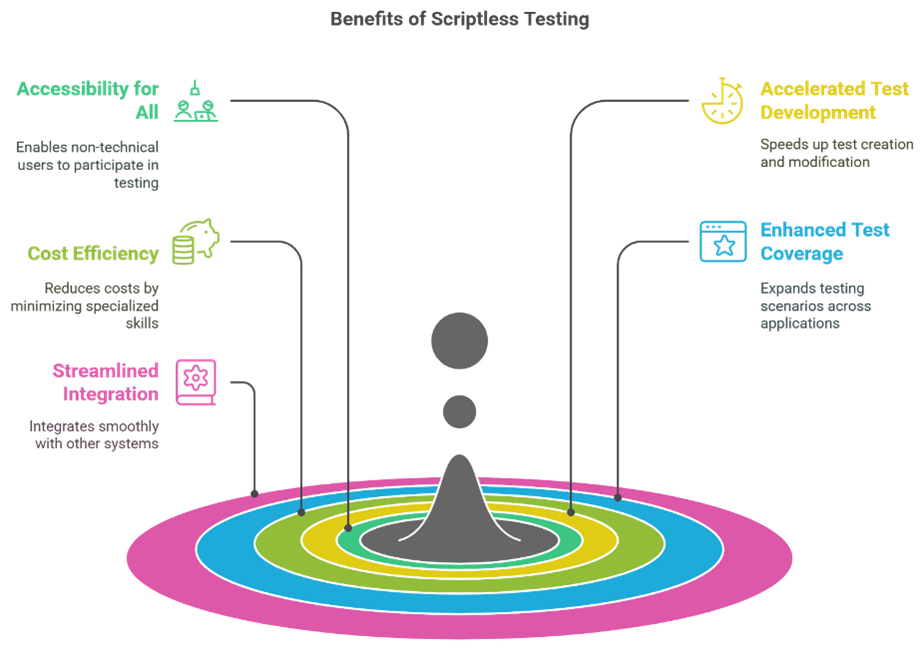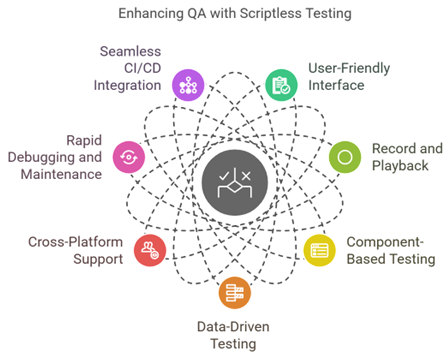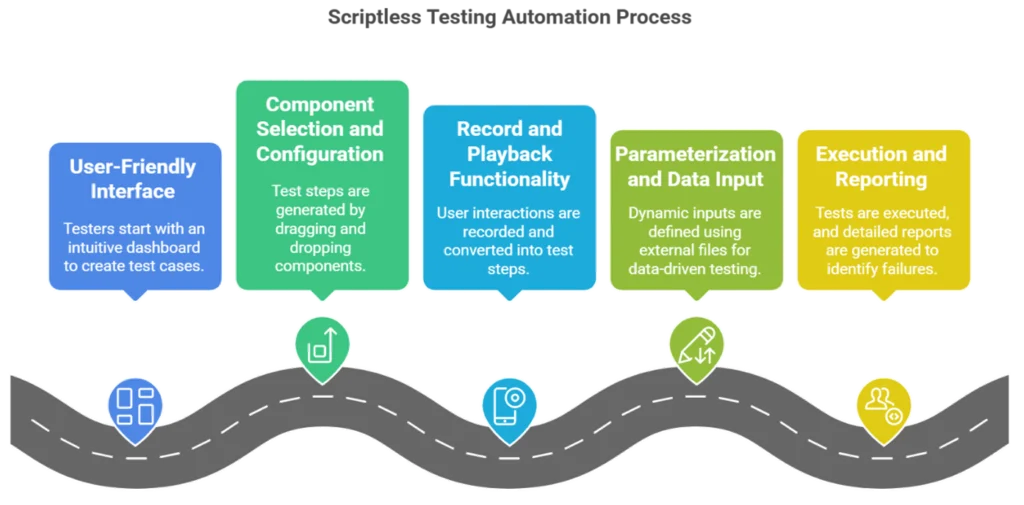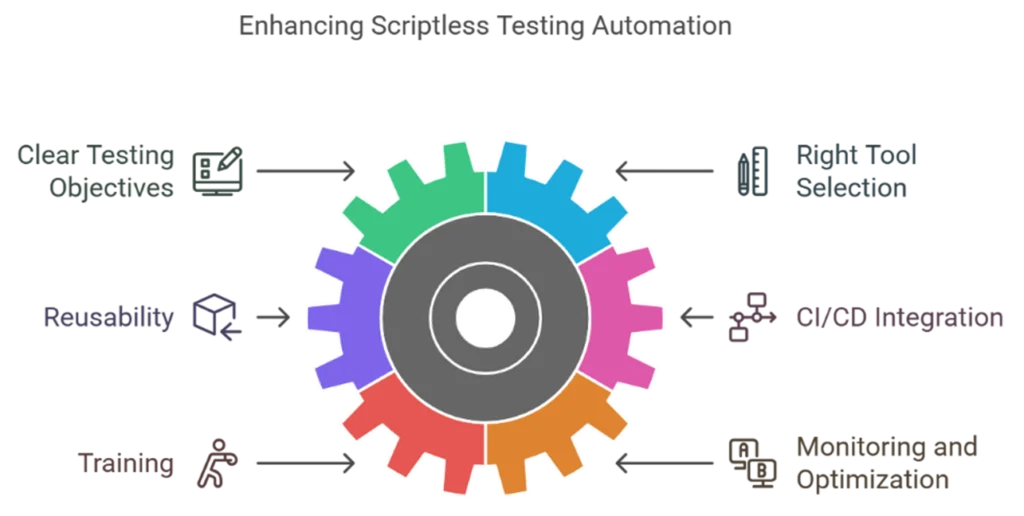What is Scriptless Testing Automation?
Scriptless testing automation refers to the practice of creating and executing automated tests without writing traditional source code. Instead, testers use intuitive, visual interfaces with drag-and-drop functionality, pre-built test components, and record-and-playback features to build test cases. This approach helps teams focus on validating business logic and user experiences rather than debugging scripts. By abstracting complex automation logic, scriptless testing empowers both technical and non-technical users to actively participate in quality assurance efforts, leading to broader collaboration and faster test development.
At its core, scriptless testing automation simplifies test creation, reduces maintenance overhead, and enables rapid test iterations—all of which are essential for agile and DevOps environments. Tools in this category often integrate with CI/CD pipelines, ensuring that testing keeps pace with short development cycles and frequent software updates.
Why Choose Scriptless Testing Automation?

Scriptless testing automation stands out for several compelling reasons:
- Accessibility for All: By removing the barrier of writing code, even non-technical personnel can design, execute, and maintain test cases. This democratization of testing ensures that business analysts, product managers, and QA professionals can collaborate more closely on software quality.
- Accelerated Test Development: With a visual and user-friendly interface, testers can quickly build and modify tests. This leads to reduced time-to-market and the ability to rapidly adjust tests when application changes occur.
- Cost Efficiency: Fewer specialized skills are required, and the reduction in manual coding means lower maintenance costs. Organizations can reallocate resources to other critical areas without sacrificing the quality of their testing processes.
- Enhanced Test Coverage: Scriptless platforms allow you to easily cover a wide range of test scenarios—from UI and API testing to integration and performance testing—ensuring comprehensive application validation.
- Streamlined Integration: Modern scriptless tools are designed to smoothly integrate with other systems such as issue tracking systems, version control platforms, and CI/CD pipelines, further simplifying the end-to-end testing process.
Key Features and Benefits

Scriptless testing automation tools offer several standout features that make them a game-changer in the world of QA:
- User-Friendly Interface: No need for programming expertise. The visual dashboard and drag-and-drop functionality mean that test creation is as simple as building a flowchart.
- Record and Playback: Many platforms allow testers to record their actions on an application and then automatically generate the corresponding test steps.
- Component-Based Testing: Pre-built components and reusable objects allow testers to quickly assemble robust test cases without starting from scratch.
- Data-Driven Testing: Easily parameterize tests by linking to external data sources like spreadsheets or databases, thereby verifying application behavior under multiple scenarios.
- Cross-Platform Support: Execute tests across different browsers, devices, and operating systems without adjusting the underlying test components.
- Rapid Debugging and Maintenance: Built-in diagnostic tools simplify troubleshooting and help maintain reuse of test cases across projects.
- Seamless CI/CD Integration: Automated tests can run continuously as part of the development lifecycle, ensuring that quality keeps pace with new releases.
Traditional Testing vs. Scriptless Testing Automation
| Feature | Traditional Scripted Testing | Scriptless Testing Automation |
| Coding Requirement | Requires in-depth programming skills and knowledge of scripting languages | No coding is required; tests are created using visual interfaces and pre-built components |
| Test Development Speed | Can be time-consuming due to manual coding and debugging | Rapid test creation with drag-and-drop and record-and-playback features |
| Maintenance Effort | Higher due to constantly changing code and test scripts | Lower as tests are modular, reusable, and easier to update |
| Collaboration | Limited to technical teams; requires upskilling non-technical staff | Inclusive for both technical and non-technical team members |
| Integration | Manual integration with CI/CD and issue-tracking systems | Built-in seamless integration with popular tools and platforms |
| Test Coverage | May require extensive effort to achieve wide coverage | Easily scalable with a focus on comprehensive coverage through graphical test development |
How Scriptless Testing Automation Works

The operation of scriptless testing automation tools generally follows these steps:
- User-Friendly Interface: Testers start with an intuitive dashboard where they can create test cases by selecting from a library of pre-built actions and verifications.
- Component Selection and Configuration: Test steps are generated by dragging and dropping the desired components based on the functional aspects being tested. Each component can be configured with parameters like input values or expected outcomes.
- Record and Playback Functionality: Some platforms allow recording user interactions with the application. The tool captures these interactions and converts them into reusable test steps.
- Parameterization and Data Input: Testers can define test scenarios using dynamic inputs sourced from external files. This supports data-driven testing, making it model robust across various data sets.
- Execution and Reporting: Once tests are composed, they can be put into execution mode where the tool runs the test cases and collects results. Detailed reports are generated to help identify and address any failures promptly.
By automating complex logic and validations behind the scenes, these tools allow even non-coders to contribute effectively to the overall testing strategy.
Common Misconceptions About Scriptless Testing Automation
Despite its many advantages, several myths continue to circulate about scriptless testing automation. It’s important to address these misconceptions to better understand its true potential:
- Myth 1: No Coding Means No Flexibility.
Reality: While basic test cases require no coding, advanced customization is still possible under the hood for handling more complex scenarios. - Myth 2: Scriptless Automation is Only for Simple Applications.
Reality: Modern scriptless tools are versatile and can handle multifaceted test scenarios, including API, mobile, and desktop testing. - Myth 3: Scriptless Testing Cannot Scale.
Reality: With the right framework, scriptless automation is highly scalable and can efficiently support enterprise-level application testing through parallel execution and CI/CD integration. - Myth 4: It is Expensive.
Reality: While some proprietary tools may have licensing fees, there are many cost-effective, open-source, or cloud-based options available that deliver robust testing without a steep financial hurdle.
Best Practices for Implementing Scriptless Testing Automation

For organizations seeking to harness the full potential of scriptless testing automation, consider these best practices:
- Define Clear Testing Objectives: Establish what aspects of your application need testing and create detailed, structured test cases.
- Choose the Right Tool: Evaluate available tools based on your project needs, support for cross-platform testing, and integration capabilities.
- Embrace Reusability: Develop modular and reusable test components. This not only reduces redundancy but also makes maintenance more efficient.
- Integrate with CI/CD: Ensure your testing tool interfaces seamlessly with your continuous integration and delivery workflows to automate testing cycles.
- Invest in Training: While no coding is necessary, understanding how to optimize and maintain your testing tools is essential for long-term success.
- Monitor and Optimize: Regularly review test reports to identify potential issues and optimize test flows accordingly.
ideyaLabs Revolutionary Approach to Scriptless Testing Automation
At ideyaLabs, we believe that high-quality testing is the backbone of robust software development. We combine intuitive user experience with powerful automation capabilities so that you can focus on innovation without worrying about technical bottlenecks.
Our solutions allow you to:
- Accelerate Testing Processes: Quickly deploy tests across web, mobile, and desktop applications with minimal setup and maintenance.
- Bridge the Skills Gap: Enable all team members—including non-technical staff—to participate in test creation and validation.
- Maximize ROI: Reduce costs associated with manual testing, accelerate time-to-market, and ensure high test coverage that adapts to changing application needs.
- Maintain High Quality: Our scriptless testing framework is designed to adapt and scale with your organization, ensuring your applications remain defect-free even as they evolve.
For more insights into our no-code testing methodology, please visit our comprehensive guide on no-code test automation at ideyaLabs No Code Test Automation Guide and learn about our cutting-edge approaches at ideyaLabs QA Solutions.
Conclusion
Scriptless Testing Automation is revolutionizing the way organizations approach quality assurance. By removing the barriers of coding and promoting collaboration across cross-functional teams, it empowers businesses to launch faster, more reliable software. With an array of powerful features—from intuitive user interfaces to seamless CI/CD integration—scriptless testing automation offers tremendous value for companies of all sizes.
At ideyaLabs, our commitment to quality, efficiency, and continuous innovation ensures that our scriptless testing solutions meet the highest standards of excellence. Take the next step towards revolutionizing your QA process by embracing scriptless testing automation with ideyaLabs. Your journey to faster, smarter, and more efficient software testing starts here.